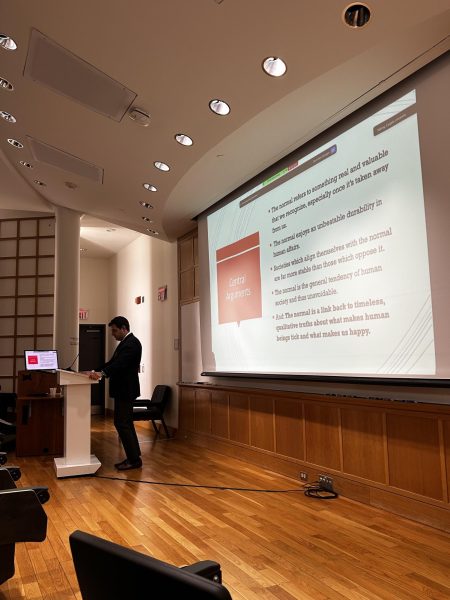Silberman on Archaeology and Religious Divisions in Israel
Neil Silberman from the Department of Anthropology at the University of Massachusetts Amherst discussed the importance of archaeology in understanding the religious and political division in contemporary Jerusalem during his lecture in Little Hall on Wednesday, March 7.
Silberman, who worked as the president of International Council on Museums and Sites’ International Scientific Committee on Interpretation and Presentation (ICIP) for a decade, structured his lecture largely in response to the Picker Art Gallery’s exhibition “This Place.” The exhibit includes photos taken by 12 photographers of Israel and the West Bank to explore the idea of placeness in areas affected by the Israel-Palestine conflict.
Silberman’s lecture focused on the ways in which excavation and, more recently, often politicized, archaeological tourism in Jerusalem help to explore which of these religious groups has the strongest claim to Jerusalem.
“The real interpretation, the real significance [of archaeology] has to be pieced together from fragmentary remains of the past, because the whole past is not there,” Silberman said. “And the glue that is used to piece them together is the logic and the fears and the hopes and the beliefs of our times. That’s why archaeological interpretation itself is constantly changing not so much from the gathering of data as the different glue that is used to put the data together.”
Jerusalem has historically been split religiously between Christians, Muslims and Jews in Israel, demonstrated by the existence of important holy sites for each religion in Jerusalem.
“The past seems to hold for many people the key to present existence both generally, in terms of empirical fact, and more importantly in terms of support for whose Jerusalem it really is,” Silberman said.
Silberman feels the area’s additional political split today between the United States, Israeli and Palestinian governments serves to further complicate the question of which religious group can claim Jerusalem. This tension was particularly heightened when President Donald Trump recognized Jerusalem as the capital of Israel and moved the United States Embassy from Tel Aviv to Jerusalem in December 2017.
“[Their argument claims] everywhere you dig in Jerusalem you find evidence of Jewish presence, which is, in a way, true. But you also find evidence of Christian presence in the Byzantine period, Muslim presence and before that those who don’t have a voice for themselves today,” Silberman said. “Archaeology in many places, particularly in Jerusalem, is so complex and interwoven that to choose where a narrative begins is completely arbitrary.”
Silberman explained the Christian Evangelical movement has used archaeology to prove its ideas about the rapture and the “apocalyptic” terrors the Bible prophesized before the return of Jesus. In the past 20 to 30 years, the evangelical dispensationalism has aligned with Israeli nationalism via political leaders’ association with leader of the Evangelical movement John Hagee.
His presence and approval of Israeli Prime Minister Benjamin Netanyahu at last year’s celebrations of the 50th anniversary of Jerusalem’s unification signifies the “eagerness” of the Israeli government to gain support from the American right.
“Israel is dependent on tourism, and the market that they have been going after in a major way is in fact American Evangelicals,” Silberman said.
The United States has seen a rise in marketing targeted at small church pastors to tour Israel with congregants in order to prove the fulfillment of biblical prophecy, relying on archaeology to back up these biblical claims.
First-year Ethan Denenberg felt the talk complemented the information he has been learning in class and in the news.
“It was really fascinating to see how the different religions and cultures interacted through the study of archaeology in a city as complex as Jerusalem. As a student currently studying religion, it was a very rewarding experience to hear about the roots of controversial religious debate from an expert like Mr. Silberman,” Denenberg said.
First-year Anna Fishman felt a new archaeological perspective changed her knowledge of the region.
“I always hear about the religious and political tension in Jerusalem in the news, but looking at these issues with an archaeological perspective really changed the way I understood them,” Fishman said.
Contact Emily Rahhal at erahhal@colgate.edu.
Emily Rahhal is a senior from Los Angeles, California double concentrating in Middle Eastern and Islamic Studies and Religion. She has previously worked...




